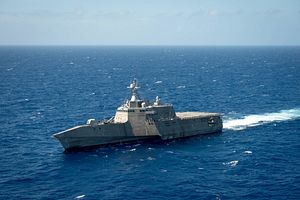The Independence-class Littoral Combat Ship (LCS) USS Coronado has started its rotational forward deployment to the U.S. Navy’s 7th Fleet area of operations, according to a U.S. Navy press release. It is the ship’s maiden voyage to Southeast Asia.
The 7th Fleet area of responsibility covers around 48 million square miles of the Pacific and Indian Oceans. Like previous LCSs, the USS Coronado will operate out of Singapore. By 2018, the U.S. Navy plans to rotationally station four LCS in the city state. The Freedom-class variants USS Forth Worth and USS Freedom have previously been deployed to the region. It is the first time that an Independence-class variant of the LCS has joined the 7th Fleet.
“Similar to the Freedom and Fort Worth deployments, Coronado will participate in exercises and engagements throughout South and Southeast Asia and beyond,” said Captain H. B. Le, the commander of Destroyer Squadron 7, the unit the USS Coronado will join during its deployment. “The LCS platform is well suited for this region and provides a unique opportunity for our partner and allied nations to operate alongside one of our Navy’s newest and most advanced platforms.”
In comparison to the Freedom-class of LCSs, the USS Coronado features a larger flight deck and has more fuel capacity increasing the ship’s operational range in comparison to the Freedom variant. The USS Coronado also for the time will operate a MH-60S Seahawk helicopter from its flight deck while on deployment in Southeast Asia.
The deployment of the USS Coronado occurs with a delay following an engineering casualty that the ship suffered en route to Singapore forcing it to temporarily return to Hawaii for repairs (See: “Dropping Like Flies: Third US Littoral Combat Ship Out of Action”). A total of five LCSs have suffered major incidents within the last twelve months.
The USS Coronado is the first LCS to be fitted with an advanced anti-ship missile system, the so-called Advanced Harpoon Weapon Control System (AHWCS) capable of firing RGM-84D Harpoon Block 1C missiles. Two Harpoon launcher structures have been installed athwartships. However, no missile canister have been installed so far.
On July 19, during RIMPAC, the USS Coronado conducted a live fire test of a Harpoon Block 1C missile aboard the vessel with mixed results (See: “RIMPAC 2016: US Navy Test-Fires Anti-Ship Missile From Littoral Combat Ship”). “The missile was launched from a canister installed on the USS Coronado’s forward deck. Yet, while the launch of the missile was successful, the Harpoon failed to hit its over-the-horizon target,” I reported on July 23.
The test firing showed that the missile can be launched from a LCS without impacting its structure. “The firing of the Harpoon missile from Coronado represented the first time over-the-horizon (OTH) missile technology has been introduced to the LCS class,” according to U.S. Pacific Command.
































